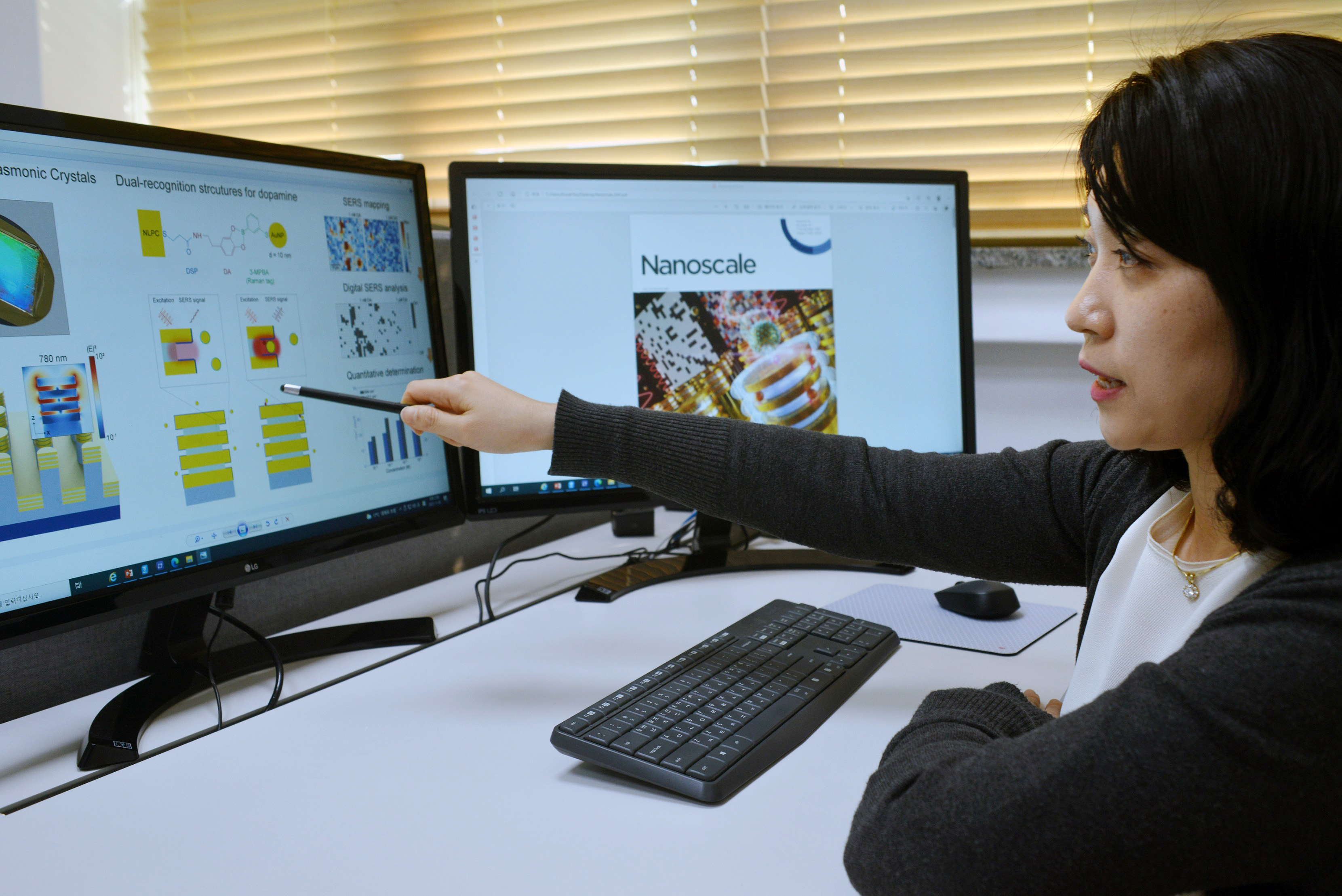Accurate Measurement of Dopamine Concentration Using Digital SERS Signal Analysis
- Writerkrissadmin
- Date2021-11-17 00:00
- Hits1920
Accurate Measurement of Dopamine Concentration
Using Digital SERS Signal Analysis
- Development of dopamine detection technique using 3D nanostructure-based digital SERS signal analysis -
- Potential for the early diagnosis and the monitoring of neurological disorders
such as Parkinson's disease and epilepsy for treatment -

▲ Principal Research Scientist Eun-Ah You gives an explanation of
the technology for accurate concentration measurement of dopamine
Korea Research Institute of Standards and Science(KRISS, President Hyun-Min Park) was successful in developing a technology for accurate concentration measurement of dopamine, an important neurotransmitter related to neurological disorders such as Parkinson’s and epilepsy, through quantitative detection.
The 3D nanostructure-based digital surface-enhanced Raman spectroscopy(SERS)* platform is significantly more accurate in the detection of dopamine by counting each event individually compared to the conventional analysis technique based on the sum of the total signal intensity. The technology is expected to be applicable to early diagnosis and the monitoring of neurological disorders for treatment.
* Surface-enhanced Raman spectroscopy(SERS): SERS is a technology for the detection of molecules or property analysis using the amplified Raman scattering effect of molecules on the surface of plasmonic metals such as gold or silver
Parkinson’s disease, a degenerative brain disease, occurs when nerve cells in the part of the brain that secretes dopamine are damaged. In the case of various addiction symptoms such as alcohol, shopping, and nicotine, excessive secretion of dopamine can continuously stimulate the frontal lobe of the brain responsible for controlling impulse, resulting in failure to control one’s own impulses.
Like this, dopamine is an important neurotransmitter related to various brain activities and physiological conditions. As dopamine is also related to immunomodulation that regulates metabolic activity and the immune system, changes in dopamine levels are critical in diagnosing various brain nerve related diseases.
To measure variations in dopamine levels for the diagnosis of neurological disorders, a sensor needs a sensitivity down to the tens of picomolar (picomole, one trillionth of a mole) range. Electrochemical sensors are one of the most well-established techniques due to their high sensitivity and rapid detection. However, this approach suffers from low selectivity because of the presence of electroactive interferents in extracellular fluids such as ascorbic acid and uric acid, which are oxidized by a very similar potential to that for dopamine.
_센싱_플랫폼.jpg)
▲ 3D nanostructure-based digital SERS sensing platform, jointly developed with Virginia Tech and the KRISS
Through joint research with Virginia Tech, Dr. Eun-Ah You at Interdisciplinary Materials Measurement Institute, KRISS developed the 3D nanostructure-based digital SERS sensing platform, presented for the first time in the world. This sensing technology can allow for detecting dopamine accurately and quantitatively with ultra high sensitivity.
The joint research team created the 3D arrays of vertically-stacked multi-nanogap hotspots* with Raman tag-conjugated Au nanoparticles, which can produce strong SERS signals for the specific binding event of dopamine.
* Hotspot: A region of very strong electromagnetic field produced when plasmonic metals like gold or silver come into close proximity(generally within a few nanometers) where a very strong SERS signal can be obtained when there are molecules within the hotspot
Accordingly, digital signal analysis was conducted in which areas in the hotspot with strong SERS signals are counted as “on” and areas without such signals are counted as “off”. Through this, dopamine was quantitatively detected with ultra high sensitivity and selectivity, down to 1 pM, which has been challenging to achieve accurately.
Dr. Eun-Ah You said, “This technique has high applicability as it can be directly applied to clinical specimens such as the human cerebrospinal fluid” and that “there are plans to develop a technology to quantitatively detect biomarkers, which are related to illnesses and infectious diseases such as Alzheimer's and the COVID19 virus, with high reliability at extremely low concentrations in the near future.”
This research was supported by the Characterization Platform for Advanced Materials funded by KRISS, and the Industrial Innovation Foundation Construction Program funded by the Ministry of Trade, Industry & Energy. The research was published as the front cover in the November issue in Nanoscale(IF: 7.790).

